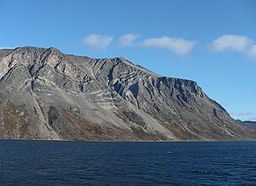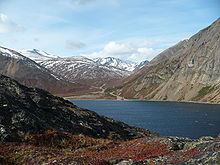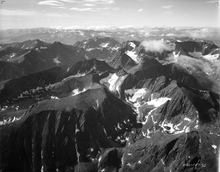- Torngat Mountains
-
Torngat Mountains Range Folded rocks of the Torngat MountainsCountry Canada Regions Labrador, Quebec Part of Arctic Cordillera Highest point Mount Caubvick - elevation 1,652 m (5,420 ft) - coordinates 58°53′01″N 63°42′57″W / 58.88361°N 63.71583°W The Torngat Mountains are a mountain range on the Labrador Peninsula at the northern tip of Newfoundland and Labrador and eastern Quebec. They are part of the Arctic Cordillera.[1] This is the peninsula that separates Ungava Bay from the Atlantic Ocean.
Contents
Extent
The Torngat Mountains have a substantial geographical extent. About 56% of the range is located in Quebec, 44% is in Labrador and the remainder, less-than-1%, is located on Killiniq Island in Nunavut. At least 2% of the mountain chain is under water, and poorly surveyed. The Torngat Mountains cover 30,067 square kilometres (11,609 sq mi), including lowland areas and extend over 300 km (186 mi) from Cape Chidley in the north to Hebron Fjord in the south. The Torngat Mountains have the highest peaks of eastern, continental Canada.
Terrain
The highest point is Mount Caubvick (also known as Mont D'Iberville) at 1,652 m (5,420 ft). There are no trees in the Torngat Mountains because the mountains are north of the Arctic tree line.
Permafrost is continuous on the Quebec side of the border, and it is extensive but discontinuous on the eastern Atlantic side. The terrain is over 300 m (984 ft) above sea level and is predominantly rocky desert.
Highest Peaks of the Torngat Mountains Rank Name m ft 1 Mount Caubvick 1652 5420 2 Torngarsoak Mountain 1595 5232 3 Cirque Mountain 1568 5144 4 Peak 5100 (24I/16) 1554+ 5100+ 5 Peak 5074 1547 5074 6 Mount Erhart 1539 5049 7 Jens Haven 1531 5023 8 Peak 5000 (24P/01) 1524+ 5000+ 9 Peak 5000 (24I/16) 1524+ 5000+ 10 Innuit Mountain 1509 4951 Geology
Precambrian gneisses that comprise the Torngat Mountains are among the oldest on Earth and have been dated at roughly 3.6 to 3.9 billion years old.[2] Geologists recognize the gneisses of the Torngats as a part of the Canadian Shield or Laurentian Upland,[3] which, composing the very old North American Craton, split from the continent of Rodinia roughly 750 million years ago to form the geologic core of North America.[4]
However, the mountain-building or orogeny of the Torngats took place much more recently, and is characteristic of the folding and faulting that defines the series of geological events known as Arctic Cordillera.[5] This, according to some, makes the Torngats, as mountains, "distinct compared to the surrounding Precambrian Canadian Shield,"[6] though they are ultimately composed of shield rock. Evidence of this dramatic cordilleran folding and faulting characterizing the Torngat Mountains can be seen distinctly in rocks where the North American Craton long ago collided with the Nain Craton, later exposed in cross-section by glacial scouring, especially at Saglek Fjord.[7]
Glaciation
The ranges of the Torngat Mountains are separated by deep fjords and finger lakes surrounded by sheer rock walls. The fjords were produced by glaciation. The Laurentide Ice Sheet covered most of the mountains at least once, however during the last ice age the coverage was more limited.
Currently, Parks Canada reports more than 40 active but small glaciers in the Torngat Mountains[8] (with about 80 ice masses [9]).
Flora and fauna
Caribou travel through the Torngat Mountains, and polar bears roam along the coast. Numerous species of vegetation common to the Arctic region of Canada are also found in the Torngat Mountains.
History & Popular culture
The name Torngat is derived from an Inuktitut word meaning place of spirits, sometimes interpreted as place of evil spirits.[10]
The Torngat Mountains National Park Reserve was announced on 1 December 2005. It aims to protect wildlife (caribou, polar bears, peregrine falcon and golden eagle among others), while offering wilderness-oriented recreational activities.[11]
In the CBC Series Geologial Journey the Torngat mountains are featured.[1] Notably, a billion year old coal seam (based on algae, not peat swamps) was discovered in the Torngat mountains on the Newfoundland Coast as part of the filming of the series.
See also
References
- ^ Park Wardens - Arctic Cordillera
- ^ "Torngat Mountains National Park Reserve". Parks Canada. http://pc.gc.ca/pn-np/nl/torngats/index_e.asp. Retrieved 2009-01-10.
- ^ http://atlas.nrcan.gc.ca/sites/english/maps/reference/anniversary_maps/physiographicregions/map.pdf
- ^ Nick Eyles and Andrew Miall, Canada Rocks: The Geologic Journey (Markham, Ont., Fitzhenry & Whiteside: 2007) pp. 66-67.
- ^ Nick Eyles and Andrew Miall, Canada Rocks: The Geologic Journey (Markham, Ont., Fitzhenry & Whiteside: 2007)
- ^ Exhumation of the Torngat Mountains, Northern Labrador, Canada, J. P. Centeno, D. F. Stockli, J. Gosse. http://www.geo.ku.edu/programs/tectonics/centeno2.html
- ^ Nick Eyles and Andrew Miall, Canada Rocks: The Geologic Journey (Markham, Ont., Fitzhenry & Whiteside: 2007) p. 100.
- ^ "Torngat Mountains National Park Reserve". Parks Canada. http://pc.gc.ca/pn-np/nl/torngats/index_e.asp. Retrieved 2009-01-10.
- ^ T.Bell, N.Barrand, P.Leblanc and M.Sharp (2008). Glacier observations in the Torngat Mountains, Northern Labrador. International Arctic Change 2008 Conference. December 9-12, 2008. Quebec City, Quebec..
- ^ "Torngat Mountains National Park Reserve". Parks Canada. http://pc.gc.ca/pn-np/nl/torngats/index_e.asp. Retrieved 2009-01-10.
- ^ "Torngat Mountains National Park Reserve". Parks Canada. http://pc.gc.ca/pn-np/nl/torngats/index_e.asp. Retrieved 2008-06-17.
Further reading
- Ives, J. D. 1957. "Glaciation of the Torngat Mountains, Northern Labrador". Arctic. 10, no. 2: 67-87.
- Kobalenko, Jerry. 2007. "Ghost Coast - Kayaking the Foreboding Fiords of Torngat Mountains National Park". Canadian Geographic. 127, no. 3: 38.
- Schaefer, James A, and Stuard N Luttich. 1998. "Articles - Movements and Activity of Caribou, Rangifer Tarandus Caribou, of the Torngat Mountains, Northern Labrador and Quebec". The Canadian Field-Naturalist. 112, no. 3: 486.
External links
- Torngat Mountains
- Great photos of the mountain range
- Statistics Canada Principal heights by range or region
- Tales from the Torngats, August 2004
- Alexander Forbes Collection: Aerial photo survey of Labrador from 1931, 1932, and 1935 expeditions - University of Wisconsin-Milwaukee Libraries Digital Collections
- Torngat Mountains: Canada's newest national park
Coordinates: 59°25′N 64°30′W / 59.417°N 64.5°W
Geography Branches Behavioral · Cultural · Demography · Development · Economic · Feminist · Health · Historical · Political · Regional · UrbanTechniques and tools Societies American Geographical Society · Association of American Geographers · European Geography Association · Geographical Association · Hong Kong Geographical Association · International Geographical Union · National Geographic Society · Royal Canadian Geographical Society · Royal Geographical Society · Royal Scottish Geographical Society · Russian Geographical Society · Saudi Geographical Society · Société de Géographie · Society of Woman GeographersGeographers Subfields of physical geography  Categories:
Categories:- Labrador
- Mountain ranges of Newfoundland and Labrador
- Mountain ranges of Quebec
- Mountains of Newfoundland and Labrador
- Arctic Cordillera
- Physiographic sections
Wikimedia Foundation. 2010.



